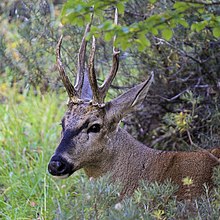South Andean deer
| South Andean deer | |
|---|---|
 |
|
| Scientific classification | |
| Kingdom: | Animalia |
| Phylum: | Chordata |
| Clade: | Synapsida |
| Class: | Mammalia |
| Order: | Artiodactyla |
| Family: | Cervidae |
| Subfamily: | Capreolinae |
| Genus: | Hippocamelus |
| Species: | H. bisulcus |
| Binomial name | |
|
Hippocamelus bisulcus Molina, 1782 |
|
 |
|
| Geographic range | |
 |
|
| Context | nature conservation |
|---|---|
| Effective | 4 December 2010 |
| Signatories | |
| Languages | Spanish |
The south Andean deer (Hippocamelus bisulcus), also known as the Chilean guemal or huemul (/ˈweɪmuːl/ WAY-mool, Spanish: [weˈmul]), is an endangered species of deer native to the mountains of Argentina and Chile. One of two mid-sized deer of the Hippocamelus genus, the south Andean deer ranges across the high mountainsides and cold valleys of the Andes. The distribution and habitat, behaviour, and diet of the deer have all been the subject of study. The viability of the small remaining population is an outstanding concern to researchers.
The huemul is part of Chile's national coat of arms and it is since 2006 a National Natural Monument.
The south Andean deer is well-adapted to broken, difficult terrain with a stocky build and short legs. A brown to greyish-brown coat tapers to white undersides and a white marked throat; the long, curled hairs of the coat provide protection against cold and moisture. Does are 70 to 80 kg. (154-176 lbs.) and stand 80 cm. (31 in.), while bucks are 90 kg (198 lbs.) and 90 cm (35 in). (Other weight suggestions are lower.) There is no sexual size difference amongst fawns, which are born unspotted.
Sexual dimorphism is notable. Only the bucks have antlers, which are shed each year toward the end of winter. Males also have a distinctive black "face mask", which curves into an elongated heart-shape surrounding a forehead of the principal brown colour. Unusually for a dimorphic ungulate, research has shown south Andean deer will congregate in mixed-sex groups, and the length of time spent inter-mixing increases with group size. The farther the animals are from rocky slopes the larger the size of observed groups, suggesting predation rates are lowest on slopes and greatest in open areas such as valley bottoms.
...
Wikipedia

